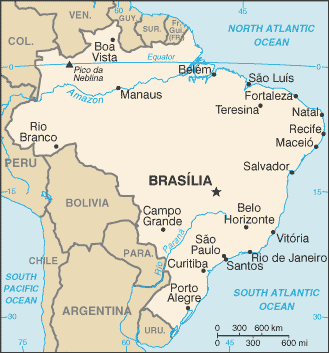Difference between revisions of "Curitiba (Paraná, Brazil)"
| [unchecked revision] | [checked revision] |
GameoAdmin (talk | contribs) (CSV import - 20130816) |
m |
||
| (One intermediate revision by one other user not shown) | |||
| Line 1: | Line 1: | ||
| − | + | [[File:Brazil.gif|329px|thumb|right|''Curitiba, Brazil'']] | |
| + | Curitiba, [[Brazil|Brazil]] was founded in 1654 as a gold mining camp, and since 1854 the capital of the State of Paraná in southeast Brazil, Curitiba is situated 905 meters (3,000 ft.) above sea level near the Atlantic rim of the Brazilian Highlands and headwaters of the Iguaçu River. Inverted umbrella-like <em> pinheiros </em> (pines) and lush <em> mate </em> (tea) trees are native to the surrounding subtropical forest and the pride of over one million <em> curitibanos </em> (inhabitants of Curitiba). | ||
The population forms a mix of original nationals with Italian, German, and Polish immigrants from the 19th century, and large additions from Syria and Japan in the 20th century. | The population forms a mix of original nationals with Italian, German, and Polish immigrants from the 19th century, and large additions from Syria and Japan in the 20th century. | ||
| Line 6: | Line 7: | ||
The first Mennonite family settled there in 1931. Since then until the early 1950s, more than 50 percent of all Brazilian Mennonites moved from the Stolzplateau and [[Krauel Colony (Alto Krauel District, Santa Catarina, Brazil)|Krauel]] colonies to Curitiba and surrounding areas to enter dairy farming, business ventures, agriculture, or professional careers. | The first Mennonite family settled there in 1931. Since then until the early 1950s, more than 50 percent of all Brazilian Mennonites moved from the Stolzplateau and [[Krauel Colony (Alto Krauel District, Santa Catarina, Brazil)|Krauel]] colonies to Curitiba and surrounding areas to enter dairy farming, business ventures, agriculture, or professional careers. | ||
| − | |||
| − | |||
= Bibliography = | = Bibliography = | ||
| − | + | Pauls, Peter, Jr. ed. <em> Mennoniten in Brasilien: Gedenkschrift zum 50 Jahr-Jubiläum ihrer Einwanderung, 1930-1980</em>. Witmarsum: n.p., 1980. | |
| − | + | {{GAMEO_footer|hp=Vol. 5, p. 214|date=1990|a1_last=Kasdorf|a1_first=Hans|a2_last= |a2_first= }} | |
| − | |||
| − | {{GAMEO_footer|hp=Vol. 5, p. 214|date= | ||
Latest revision as of 03:28, 17 October 2013
Curitiba, Brazil was founded in 1654 as a gold mining camp, and since 1854 the capital of the State of Paraná in southeast Brazil, Curitiba is situated 905 meters (3,000 ft.) above sea level near the Atlantic rim of the Brazilian Highlands and headwaters of the Iguaçu River. Inverted umbrella-like pinheiros (pines) and lush mate (tea) trees are native to the surrounding subtropical forest and the pride of over one million curitibanos (inhabitants of Curitiba).
The population forms a mix of original nationals with Italian, German, and Polish immigrants from the 19th century, and large additions from Syria and Japan in the 20th century.
A modern business center, the city is proud of its uniquely planned and developed industrial district, its many banks, and its more than 14,000 commercial establishments that collectively account for sustained economic growth. Paper, leather goods, furniture, and foods are among the principal manufactured items. All this plus a healthy climate and easy access by road, rail, and air, make Curitiba an attractive place to live.
The first Mennonite family settled there in 1931. Since then until the early 1950s, more than 50 percent of all Brazilian Mennonites moved from the Stolzplateau and Krauel colonies to Curitiba and surrounding areas to enter dairy farming, business ventures, agriculture, or professional careers.
Bibliography
Pauls, Peter, Jr. ed. Mennoniten in Brasilien: Gedenkschrift zum 50 Jahr-Jubiläum ihrer Einwanderung, 1930-1980. Witmarsum: n.p., 1980.
| Author(s) | Hans Kasdorf |
|---|---|
| Date Published | 1990 |
Cite This Article
MLA style
Kasdorf, Hans. "Curitiba (Paraná, Brazil)." Global Anabaptist Mennonite Encyclopedia Online. 1990. Web. 21 Nov 2024. https://gameo.org/index.php?title=Curitiba_(Paran%C3%A1,_Brazil)&oldid=102634.
APA style
Kasdorf, Hans. (1990). Curitiba (Paraná, Brazil). Global Anabaptist Mennonite Encyclopedia Online. Retrieved 21 November 2024, from https://gameo.org/index.php?title=Curitiba_(Paran%C3%A1,_Brazil)&oldid=102634.
Adapted by permission of Herald Press, Harrisonburg, Virginia, from Mennonite Encyclopedia, Vol. 5, p. 214. All rights reserved.
©1996-2024 by the Global Anabaptist Mennonite Encyclopedia Online. All rights reserved.

